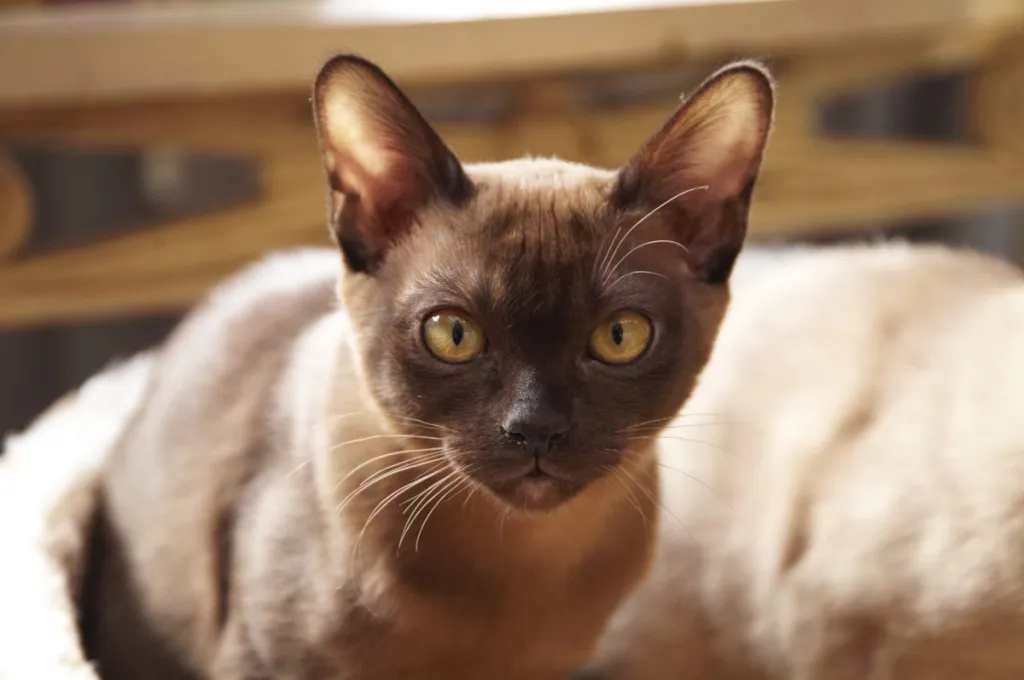The European Burmese cat is a breed known for their sleek and muscular build, almond-shaped eyes, and short, shiny coat. Originating from the United Kingdom, this breed is distinct from the Burmese, with some variations in appearance and breeding standards. European Burmese cats have a distinctive coat color that is darker on the back and lighter on the stomach, known as the “colorpoint” pattern. The breed comes in various colors, including sable, champagne, blue, and platinum. Known for their social and affectionate nature, European Burmese cats form strong bonds with their human companions and are often described as being people-oriented. They are intelligent, curious, and enjoy interactive play, making them well-suited for families and individuals seeking a lively and engaging feline companion.
In terms of health, European Burmese cats are generally robust, but like any breed, they may be prone to certain genetic conditions. Regular veterinary check-ups, a balanced diet, and proper care are essential to ensure their well-being. With their striking appearance, friendly disposition, and active nature, European Burmese cats have gained popularity among cat enthusiasts and continue to be cherished pets in households around the world.
When considering a European Burmese kitten, it’s advisable to prioritize adopting from rescue organizations or shelters to provide a loving home to a cat in need. However, if you decide to purchase, it’s crucial to choose a reputable breeder. Conduct thorough research to ensure that the breeder follows ethical practices and prioritizes the well-being of their cats. Reputable European Burmese kitten breeders prioritize the health and temperament of their cats, conduct necessary health screenings, and provide a nurturing environment for the kitties. This active approach ensures that you bring home a healthy and happy kitty while discouraging unethical breeding practices.
Quick Facts
- Origin: Europe, distinct lineage from American Burmese, developed through selective breeding from Southeast Asian imports.
- Size: Medium (9-13 pounds), slightly larger than their American counterparts.
- Breed Group: Semi-Longhaired Domestic (not recognized by major associations)
- Lifespan: 10-17 years
- Coat: Short to semi-longhaired, with a luxurious plushness and stunning chocolate brown color (can also be blue, lilac, or champagne).
- Temperament: Loving, playful, intelligent, social, talkative, enjoys human interaction and playtime, known for their “dog-like” personalities.
- Exercise Needs: Moderate – needs daily playtime and mental stimulation but also enjoys cuddles.
- Training: Highly trainable due to their intelligence and desire to please, can learn tricks and even leash training.
- Grooming: Regular brushing is essential to prevent matting, especially with semi-longhaired varieties.
- Health: Generally healthy, but some potential for genetic health conditions like hypertrophic cardiomyopathy (HCM) and diabetes mellitus.
- The European Burmese cat is also known as the British Burmese, or traditional.
- The European Burmese cat has a smaller, wedge-shaped head, almond eyes, and a slimmer body than the American Burmese.
- All modern Burmese cats (both lines) originate from the same source: Wong Mau.
European Burmese Pictures

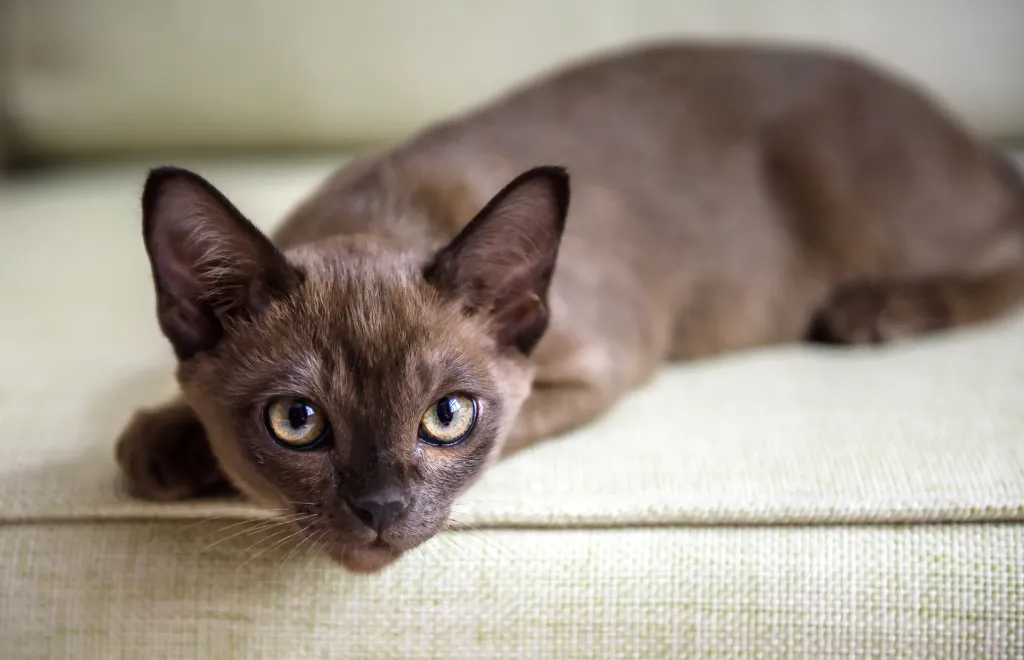
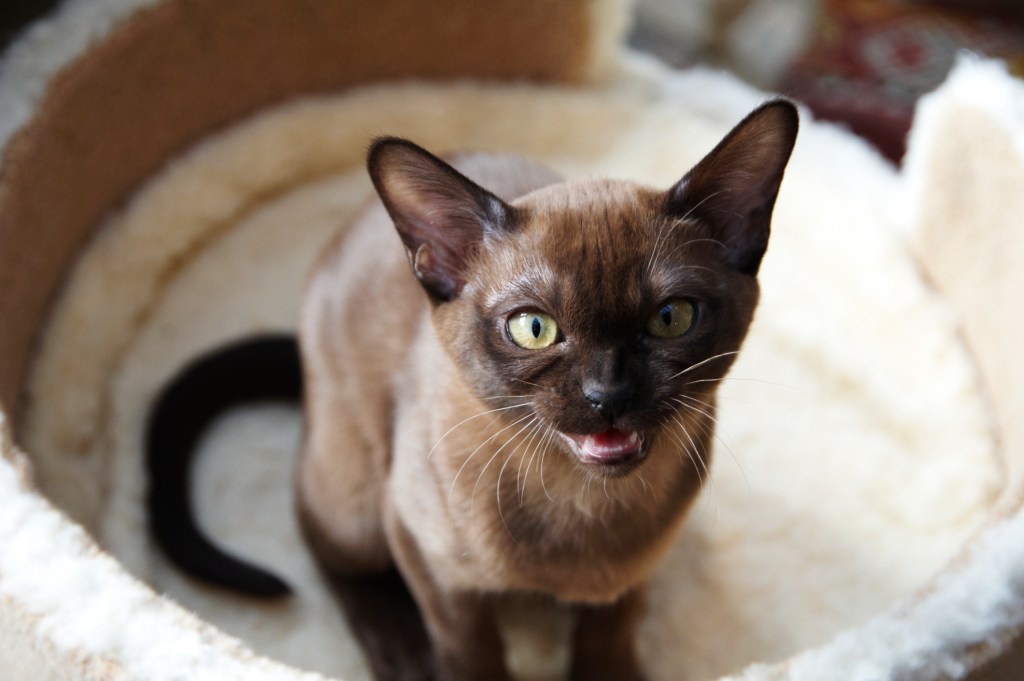
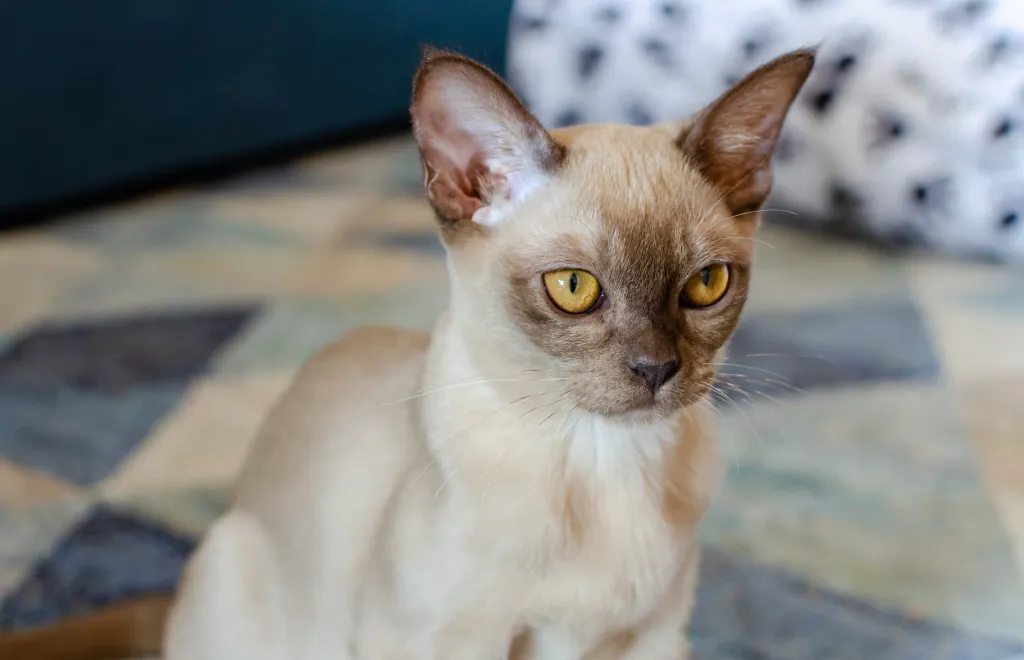
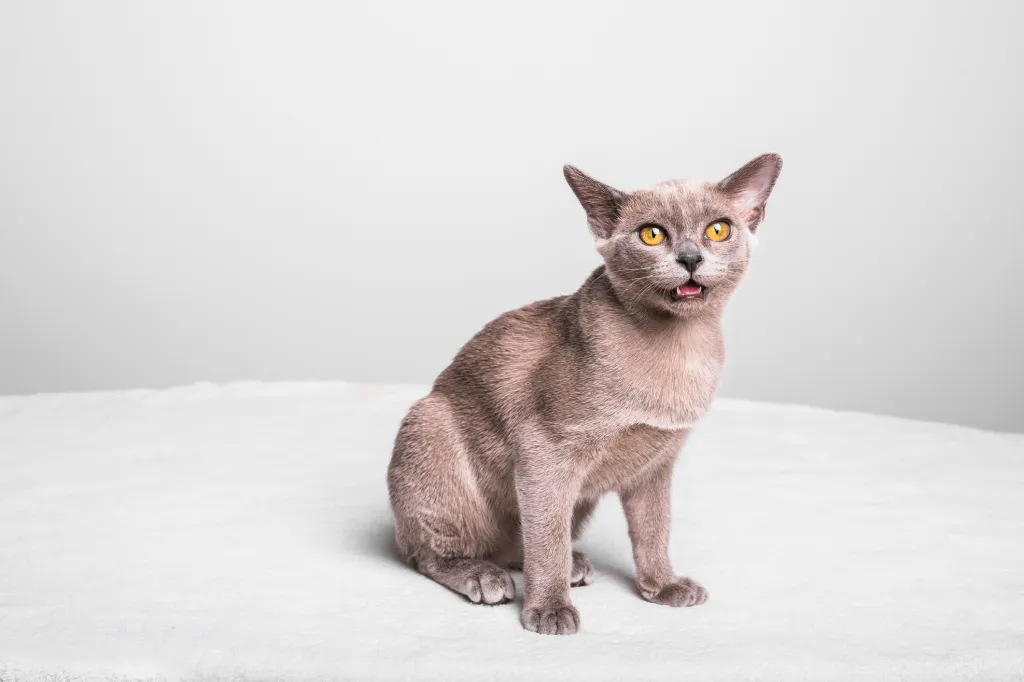
-
Affectionate with Family
Some cat breeds are typically independent and aloof, even if they’ve been raised by the same person since kittenhood; others bond closely to one person and are indifferent to everyone else; and some shower the whole family with affection. Breed isn’t the only factor that goes into affection levels; cats who were raised inside a home with people around feel more comfortable with humans and bond more easily.

See Cats Less Affectionate with Family -
Amount of Shedding
If you’re going to share your home with a cat, you’ll need to deal with some level of cat hair on your clothes and in your house. However, shedding does vary among the breeds. If you’re a neatnik, you’ll need to either pick a low-shedding breed or relax your standards. This furniture cover can make it easier to clean up cat hair and keep it off your sofa!
-
General Health
Due to poor breeding practices, some breeds are prone to certain genetic health problems. This doesn’t mean that every cat of that breed will develop those diseases; it just means that they’re at an increased risk. If you’re looking only for purebred cats or kittens, it’s a good idea to find out which genetic illnesses are common to the breed you’re interested in.
-
Potential for Playfulness
Some cats are perpetual kittens—full of energy and mischief—while others are more serious and sedate. Although a playful kitten sounds endearing, consider how many games of chase the mouse-toy you want to play each day, and whether you have kids or other animals who can stand in as playmates. A classic wand cat toy like this one is perfect for playful felines!
-
Tendency to Vocalize
Some breeds sound off more often than others with meows, yowls, and chattering. When choosing a breed, think about how the cat vocalizes and how often. If constant “conversation” drives you crazy, consider a kitty less likely to chat.
-
Kid-Friendly
Being tolerant of children, sturdy enough to handle the heavy-handed pets and hugs they can dish out, and having a nonchalant attitude toward running, screaming youngsters are all traits that make a kid-friendly cat. Our ratings are generalizations, and they’re not a guarantee of how any breed or individual cat will behave; cats from any breed can be good with children based on their past experiences and personality.
-
Friendly Toward Strangers
Stranger-friendly cats will greet guests with a curious glance or a playful approach; others are shy or indifferent, perhaps even hiding under furniture or skedaddling to another room. However, no matter what the breed, a cat who was exposed to lots of different types, ages, sizes, and shapes of people as a kitten will respond better to strangers as an adult.
-
Easy to Groom
Some breeds require very little in the way of grooming; others require regular brushing to stay clean and healthy. Consider whether you have the time and patience for a cat who needs daily brushing. You should definitely pick up this awesome de-shedding tool for cats of any hair length!
-
Intelligence
Some cat breeds are reputed to be smarter than others. But all cats, if deprived the mental stimulation they need, will make their own busy work. Interactive cat toys are a good way to give a cat a brain workout and keep them out of mischief. This scratcher cat toy can keep your smart kitty busy even when you’re not home!
-
Pet Friendly
Friendliness toward other household animals and friendliness toward humans are two completely different things. Some cats are more likely than others to be accepting of other pets in the home.
European Burmese History
The ancestors of the Burmese are the Siamese and the “copper cat” of Burma (now known as Myanmar). It’s thought that they were temple and palace cats bred and kept by priests. The matriarch of the modern Burmese was a small, dark-brown cat named Wong Mau. She belonged to Dr. Joseph Thompson, who either acquired her from a sailor or brought her back himself from his travels, depending on which story you believe.
Wong Mau was at first thought to be a Siamese with a chocolate-colored coat. Such Siamese wasn’t unheard of. “Chocolate Siamese” were described in the 1880s. Their bodies were tan or brown, and they had seal-brown or nearly black points. The seal-point Siamese, also known as royal Siamese, had lighter bodies that contrasted with their dark points and were preferred by breeders and the public.
The chocolate-colored cats eventually disappeared in Britain, but they still existed in Thailand and Burma, where they were probably the offspring of natural (as opposed to human-directed) matings between free-roaming Siamese (pointed) and solid-colored Burmese cats. Wong Mau was one of them. It was her destiny to become the matriarch of two new breeds: the Burmese and, later, the Tonkinese.
Dr. Thompson bred Wong Mau to a seal-point Siamese named Tai Mau. His breeding program, in conjunction with breeders Virginia Cobb and Billie Gerst and geneticist Clyde Keeler, produced kittens with beige, brown, and pointed coats. The results, including the discovery of the Burmese gene, were so interesting that Thompson published an article on the subject in the Journal of Heredity, the first such piece on feline genetics. The brown cats were chosen to develop as a new breed: the Burmese.
The Cat Fanciers Association began registering Burmese in 1936 but suspended registrations in 1947 because breeders were still using Siamese in their breeding programs. Registrations resumed in 1953 after the practice was stopped. In Europe, however, the development of the Burmese took a different path.
In Great Britain, where there was an even greater lack of breeding stock than in the United States, redpoint Siamese and British Shorthairs were used in breeding programs, and their genetic contribution included additional colors: red, cream, brown-tortie, chocolate-tortie, blue-tortie and lilac-tortie. They eventually became known as Foreign Burmese, or European Burmese.
European Burmese Size
This medium-sized cat breed usually weighs six to 10 pounds, sometimes more.
European Burmese Personality
The European Burmese shares a similar personality with the Burmese, marked by energy and friendliness. This breed carries the charm and determination of its Siamese ancestors and enjoys engaging in conversations, though its voice is soft and sweet. Despite this gentle tone, the European Burmese is a confident leader, often running the household with an “iron paw” cloaked in velvety fur.
Highly intelligent and deeply social, the European Burmese thrives on human interaction. It is not an ideal pet for a home where it will be left alone for long periods. If human companionship is unavailable, ensure the cat has another pet to bond with. They get along well with other cats and dogs, though another Burmese—European or otherwise—often makes the perfect companion.
Curiosity defines the European Burmese. Expect this cat to thoroughly explore every corner of your home, uncovering all its secrets. Playful even into adulthood, it enjoys interactive toys and can learn tricks like sitting, rolling over, waving, and fetching. With patience, you can even teach it to walk on a leash, making this cat as versatile as it is entertaining.
Early socialization makes car rides and vet visits stress-free for this adaptable breed. Be prepared for a cat that wants to be involved in every aspect of your life, from reading and cooking to working and relaxing. Privacy is not part of the package with a European Burmese, as it will likely claim your lap, sleep on your bed (possibly under the covers), and demand your attention if ignored.
This sociable cat extends its charm to guests, often winning over even those who are indifferent to cats. Female European Burmese are regal and assertive, enjoying attention and taking charge, while males are more laid-back and content to occupy a lap. Regardless of which you choose, you may find yourself unable to resist the urge to welcome another into your home.
European Burmese Health
Both pedigreed cats and mixed-breed cats have varying incidences of health problems that may be genetic. European Burmese are generally healthy, although they can be prone to gingivitis and may be sensitive to anesthesia. The following diseases have also been seen in European Burmese:
- Lipemia of the Aqueous Humor: This is a transient milky appearance of the eye during kittenhood, which usually resolves on its own.
- Corneal Dermoid: The presence of skin and hair on the surface of the cornea, which can be successfully corrected surgically.
- Gangliosidosis: This is an enzyme deficiency. A test has been developed that will allow the disease to be detected.
- Orofacial Pain Syndrome: This is indicated by exaggerated licking and chewing motions and pawing at the mouth. The discomfort can increase when the cat is excited or stressed, and the cats often are reluctant to eat because the activity is painful. Some cats must wear an Elizabethan collar and have their paws bandaged so they don’t hurt themselves. Some cases resolve on their own, then recur. The cause and the mode of inheritance are unknown. Pain medications and anti-seizure drugs can help, as can consultation with a veterinary dentist to rule out dental disease.
- Congenital Peripheral Vestibular Disease: A disease-causing head tilting, poor balance, rapid eye movements, and uncoordinated walking in kittens. Some kittens with the condition may also be deaf.
- Kinked Tail: This is usually a result of a deformity of the tailbone. It causes no pain or discomfort.
- Elbow Osteoarthritis: This is an early onset of arthritis in the elbow, limiting the cat’s activity or mobility.
- Endocardial Fibroelastosis: This is a heart condition in which the left ventricle of the heart thickens, stretching the heart muscle. Signs usually develop when a kitten is 3 weeks to 4 months old, good reason to wait until 4 months to bring a kitten home.
- Dilated Cardiomyopathy: This is an enlarged heart. Dilated Cardiomyopathy (DCM) is a heart condition that can affect cats, impacting the structure and function of the heart muscle. Unlike some other heart issues, DCM is not typically associated with genetic predisposition in cats.
- Diabetes Mellitus: A type of endocrine condition caused by a defect in insulin secretion or insulin action that results in high levels of sugar in the blood.
European Burmese Care
The soft, short coat of the European Burmese is easily cared for with weekly brushing or combing to remove dead hair and distribute skin oil. A bath is rarely necessary. Brush the teeth to prevent periodontal disease. Daily dental hygiene is best, but weekly brushing is better than nothing.
Wipe the corners of the eyes with a soft, damp cloth to remove any discharge. Use a separate area of the cloth for each eye so you don’t run the risk of spreading any infection. Check the ears weekly. If they look dirty, wipe them out with a cotton ball or soft damp cloth moistened with a 50-50 mixture of cider vinegar and warm water. Avoid using cotton swabs, which can damage the interior of the ear.
Keep the litter box spotlessly clean. Like all cats, European Burmese are very particular about bathroom hygiene. It’s a good idea to keep a European Burmese as an indoor-only cat to protect him from diseases spread by other cats, attacks by dogs or coyotes, and the other dangers that face cats who go outdoors, such as being hit by a car. European Burmese who go outdoors also run the risk of being stolen by someone who would like to have such a beautiful cat without paying for it.
European Burmese Coat Color And Grooming
Besides color, the European Burmese and the Burmese have other differences in appearance. The European has a more moderate appearance, especially when it comes to head type. He is more gently rounded with a body that is less compact but never long and slinky like that of the Siamese.
The top of the head is slightly rounded with plenty of space between the ears and wide cheekbones that taper to a short, blunt wedge. The eyes, which range in color from yellow to amber, slant more toward the nose and have a less rounded opening than the eyes of the Burmese.
Medium-size ears are slightly rounded at the tips and tilt slightly forward. Slender legs are supported by small, oval paws. A medium-length tail tapers slightly to a rounded tip. Like the Burmese, the European Burmese is heavier than he looks and can also lay claim to the description “a brick wrapped in silk.”
He wears a short and satiny coat that comes in 10 different colors: brown, blue, chocolate, lilac, red, cream, and brown, blue, chocolate, and lilac tortoiseshell. The coat colors shade gradually to the roots, with the underside of the body slightly lighter than the top. The red European Burmese comes in a warm orange apricot shade and may have slight tabby markings on the face. Cream-colored cats may also have slight tabby markings, and their nose leather and paw pads are pink. Blue is the same as in the Burmese, and the lilac coat is the same as the platinum coat of the Burmese. Brown is a rich, warm, seal brown, and chocolate is a warm milk chocolate color. The tortoiseshells have patches of color over the entire body.
Children And Other Pets
The active and social European Burmese is a perfect choice for families with children and cat-friendly dogs. He will play fetch as well as any retriever, learns tricks easily, and loves the attention he receives from children who treat him politely and with respect. He lives peacefully with cats and dogs who respect his authority. Always introduce pets slowly and in controlled circumstances to ensure that they learn to get along together.
European Burmese Rescue Groups
More Info For You
If you’re also looking for a dog, check out DogTime’s dog breed page!
